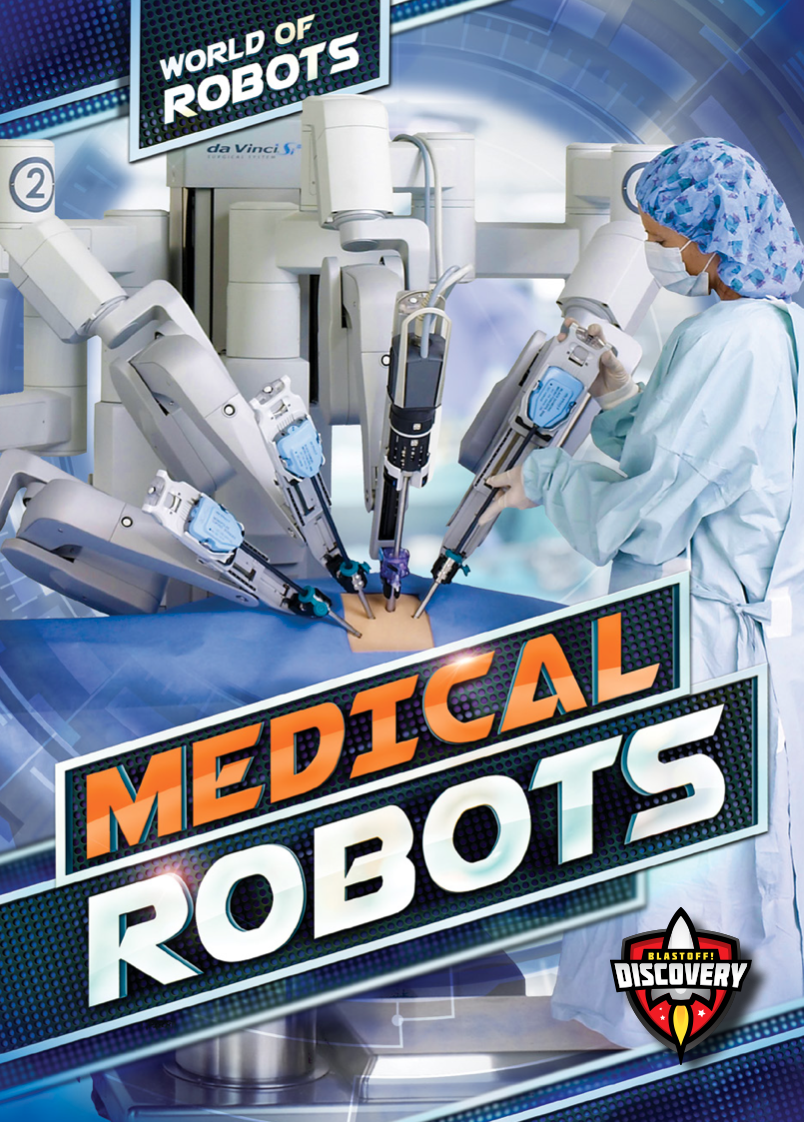
Medical Robot at Work!
Geena slumped in her chair. She didn’t want to learn about her dad’s surgery. The hospital was boring. The surgeon talked super fast and used a lot of words she did not know. Geena heard the word “robot.” Then the surgeon led them into the operating room.
There was a chunky plastic desk with a viewfinder in the top half. A machine with four arms stood next to a hospital bed. At the end of each arm were shiny metal instruments.
The surgeon sat at the desk. When he moved the controls, the machine’s arms rotated. The tiny pinchers at the ends of the arms picked up a piece of paper on the bed. Two pinchers worked together to fold the paper into an airplane.
The surgeon explained that the robot would operate on Geena’s dad while he ran the controls. The robot’s tiny, precise cuts would heal quickly, he said. The cuts will be exact.
For the first time ever, Geena wished their hospital visit could last longer.
What are Medical Robots?
Medical robots help doctors and patients in many ways. Their movements are precise and steady. Some can lift heavy things. Robots can also do boring jobs without making mistakes.
Surgical robots help by making surgery less invasive. Therapy robots can help treat injured people learn to walk again. Robots can help nurses by lifting people out of beds and into wheelchairs. Other robots help package medications and get them ready for patients.
The most common kind of medical robot is the surgical robot.
In order to operate, a surgeon must be able to see inside the patient. Also, there must be room for their hands to move. Without robots, this means making a large incision. That type of cut takes a long time to heal.
Surgical robots can perform laparoscopic surgery. They make several small cuts instead of one big one. A tiny camera goes inside the patient so the surgeon can see. Patients with smaller incisions heal faster. They also have less pain.
Many new medical robots comfort patients and help them relax. MEDi is a small robot that talks to kids who are nervous at the doctor. Keepon Pro helps children with autism. For them, the little yellow robot can be easier to talk to than adults because of their disorder that makes it hard for them to communicate and socialize.
Some robots, called exoskeletons due to their hard structures on the outside of their body, help people who are paralyzed walk. They can also help injured people relearn how to walk. One, called ReWalk, straps on over the legs and has motors at the hip and knee.
Pharmacists get medicine ready for patients. They find the right pills and count out the correct amount. Then they give the pills the proper label. If a patient gets the wrong medicine or amount, it could be a fatal error. The patient could die.
Some medical robots can count pills or package medicine for prescriptions. They are extremely careful and fast. Unlike humans, they never get bored or lose track.
The Development of Medical Robots
Medical robots have only been around for about 30 years. A surgical robot came first. In 1985, the PUMA 560 helped with difficult surgeries and brain biopsies, which is when cells are cut out of the body to identify any diseases. Scientists then invented other surgical robots, including the PROBOT and the ROBODOC.
NASA, who is in charge of space travel and exploration, also began to research robotic surgery for astronauts in space. They worked on methods for telesurgery, or ways surgeons could operate from far away. Other groups thought this technology could help wounded soldiers on battlefields. The research led to the ZEUS and da Vinci robotic surgical systems. In 2000, the government approved the da Vinci system for laparoscopic surgery.
Since da Vinci, medical robots have become more common and varied. Some, like robotic exoskeletons, are very new. Others are still in the lab, like cancer-fighting nanobots, very small robots.
As technology and robot parts become cheaper, more people can afford to build robots and experiment with them. For instance, robots have tools called sensors to figure out their surroundings. Sensors are like our eyes and ears. As sensors become cheaper, robots become cheaper. This means more people can try to come up with new ways to use robots in the medical field!
Medical Robot Profile: Da Vinci
Da Vinci is a human-controlled robot used to perform surgeries. Robotic arms work on the patient. Across the room, the surgeon sits at a console and moves hand controls that direct the robotic arms. Using the da Vinci system guarantees that the “hands” performing the surgery will always be steady.
A camera and light are attached to one of da Vinci’s arms. This lets the surgeon see inside the patient and accurately direct da Vinci’s movements.
Medical Robot Profile: RIBA
RIBA is the first robot to be able to lift and move patients. Scientists created it to help nurses. Nurses lift patients from beds to wheelchairs and back again many times a day. This often causes back injuries. Help from RIBA could prevent this. RIBA has a friendly, bearlike face with big, round eyes. Its arms are strong and made of a comfortable, soft rubber. There are more than 200 sensors in each arm. These tell how to safely move patients.
Medical Robot Profile: RIVA
RIVA is a strange-looking robot. It looks like a tollbooth or a walk-in freezer with windows. Inside the shiny metal walls, RIVA combines medication that goes into syringes or IV bags. Then it labels each by medication or patient name. RIVA is fully automated. Nobody is directing its movements with a remote control.
In most hospitals, pharmacists combine the medication for IVs by hand. RIVA’s makers say their robot’s work is safer and faster than a human’s.
Medical Robot Profile: Robot-Rx
ROBOT-Rx is like a huge vending machine with a metal arm that moves around very fast. The arm grabs a package of medicine from a storage rack. It takes the medicine to a different area and drops it into a bin or patient-specific envelope.
ROBOT-Rx uses barcodes to find the right medicines and the correct patient. These codes also help it handle returns and restocking. With ROBOT-Rx doing repetitive tasks, pharmacists have more time to help patients.
The Future of Medical Robots
Experts predict that we will soon see many more medical robots. Some will be doing everyday tasks like counting pills, taking blood, and carrying food. A space robot might be performing surgeries on astronauts without direction from a doctor on Earth. Others may be inside humans! Robots the size of a red blood cell may be fighting cancer or monitoring our health. Other medical robots will almost certainly be saving lives in ways we can only imagine right now.



 About BeeLine
About BeeLine